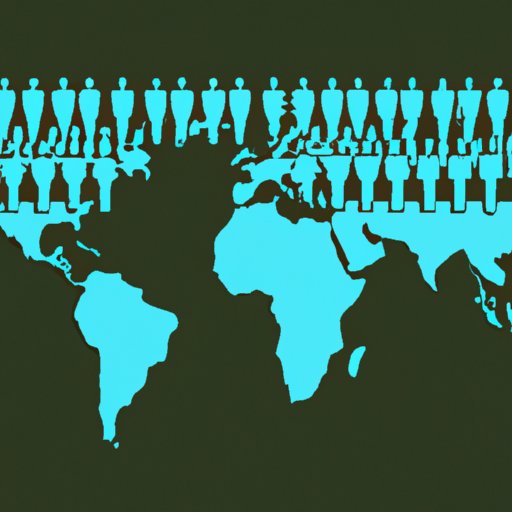Introduction
When discussing global population, there are many questions to be answered. How many people are in the world? What factors drive population growth? How does population affect the global economy? This article seeks to answer these questions by examining current population levels, regional differences in population, and the effects of migration on world population. Additionally, this article will explore the impact of population growth on the global economy and analyze major events that have impacted population levels.
The Global Population: A Statistical Look at How Many People Are in the World
According to the United Nations’ World Population Prospects 2019 report, the estimated world population as of mid-2019 was 7.7 billion people. This number is expected to reach 8.5 billion by 2030, 9.7 billion by 2050, and 11.2 billion by 2100. The report notes that most of this population growth is projected to take place in developing countries, particularly in Africa.
When looking at regional differences in population, it is evident that Asia has the highest population, with 4.5 billion people as of mid-2019. This is followed by Africa, with an estimated 1.3 billion people, and Europe, with approximately 743 million people. North America and South America both have around 590 million people each, while Oceania has around 41 million people.
Migration is another key factor when considering world population. In recent years, there has been an increase in the number of people migrating from one region to another, often due to economic or political reasons. This has had a significant impact on population levels, particularly in areas that have experienced large influxes of migrants. For example, Europe has seen a dramatic increase in the number of refugees and asylum seekers in recent years, resulting in a significant rise in population.

The Impact of Population Growth on the Global Economy
Population growth has a direct impact on the global economy. As the population increases, so does the demand for goods and services. This can lead to higher prices and inflation, which can have a negative effect on economic growth. Additionally, population growth can put pressure on existing infrastructure, such as transportation networks, housing, and energy systems, as well as natural resources, such as water and food.
There are a number of factors driving population growth across the globe. These include improved access to healthcare, increased life expectancy, and lower fertility rates. Additionally, shifts in cultural norms, such as delayed marriage and childbearing, are also contributing to population growth. In some cases, migration can also contribute to population growth, as people move to new areas in search of better economic opportunities.
The economic effects of population growth can be both positive and negative. On the one hand, population growth can lead to increased economic activity, as more people means more demand for goods and services. On the other hand, population growth can also lead to higher unemployment, as the labor force is unable to keep up with the increasing demand for jobs. Additionally, population growth can put strain on existing infrastructure and natural resources, leading to higher costs for businesses and individuals.
The relationship between population and natural resources is an important one to consider. As the population increases, so does the demand for natural resources, such as water and food. This can lead to environmental degradation, as well as competition for scarce resources. Additionally, it can lead to higher prices for essential goods, as the demand outstrips the supply.

Major Events and their Impact on Global Population Levels
Throughout history, there have been a number of major events that have impacted global population levels. One example is the Black Death, which killed an estimated 75 to 200 million people in Eurasia during the 14th century. This event had a significant impact on population levels in Europe, leading to a decrease in population and a shift in power dynamics.
More recently, the Great Recession of 2008 had a major impact on global population levels. This economic crisis caused millions of people to lose their jobs, leading to a decrease in population in certain areas. Additionally, the Syrian Civil War, which began in 2011, resulted in an estimated 11.7 million people fleeing the country, resulting in a significant population shift in the region.
Conclusion
In conclusion, this article has examined how many people are in the world and explored the factors that drive population growth. It has discussed the impact of population growth on the global economy, as well as major events that have impacted population levels. Ultimately, it is clear that population is a complex issue that has far-reaching implications for the global economy and society as a whole.
Overall, this article has highlighted the importance of understanding population dynamics and the implications they have for the global economy. Further research is needed to better understand the impact of population growth on natural resources and the environment, as well as the economic effects of population shifts due to migration and other factors.


